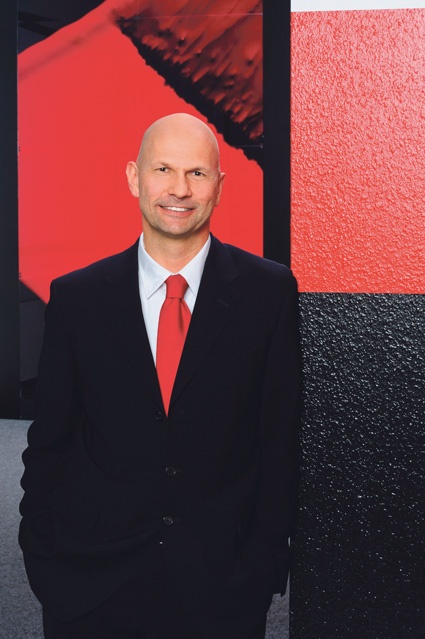Urbanization as a Growth Driver
Specialty chemicals company Lanxess is expanding its global production network for inorganic pigments and building a new plant in China for the Inorganic Pigments business unit. The new facility for high-quality iron oxide red pigments is being erected at a cost of €55 million at the chemical park in Ningbo, on the eastern coast of China.

The pigments will be marketed worldwide under the product name Bayferrox and are intended for use in the paints and coatings sector and in the construction and plastics industries. The rising demand for these high-quality and sustainably produced pigments is being driven by growing urbanization - a megatrend and a key focal point in Lanxess' growth strategy. Michael Reubold asked Jörg Hellwig, head of the Inorganic Pigments business unit at Lanxess, about his strategy for the unit.
CHEManager Europe: Mr. Hellwig, the investment in the new plant in Ningbo underlines the importance of urbanization as a megatrend for Lanxess and the Inorganic Pigments business unit. What kind of growth do you expect worldwide for inorganic iron oxide pigments?
J. Hellwig: We look at a range of studies and our customers' growth plans and analyze the markets. All our findings show that the global market for iron oxide pigments is continuously growing. When viewed in detail, the rate of growth differs from region to region and according to the area of application. The new facility in Ningbo will give us additional capacity that we can use to serve the growing markets across the world. For example, the construction industry is set to grow by 3.5% worldwide this year and by 5% next year. What's more, we have optimized our processes so that we can respond faster to increased volatility.
What exactly is driving growth?
J. Hellwig: One of the main growth drivers for our sector is the megatrend of urbanization. The construction, plastics and paint and coatings industries all benefit from this trend. People are flocking to cities and ever larger urban conurbations are springing up. Furthermore, although urban planning originally had an entirely utilitarian focus and was geared solely towards creating space, modern approaches are increasingly taking esthetic dimensions into account, too. Architects are thinking about how they can make concrete more attractive, and sooner or later they come across our pigments. Whether paving materials, roofing tiles, wall coatings, laminates or artificial grass, colorful objects that don't require extensive maintenance work and are produced on a sustainable basis are in greater demand than ever before.
Are there other applications driving growth?
J. Hellwig: Lanxess has identified three further megatrends besides urbanization that serve as focal points for our business strategy and we offer iron oxide pigments for all of them. Bayoxide E 33 is relevant to the megatrend of water because it is highly effective in binding arsenic, enabling the purification of drinking water in all regions of the world. Bayoxide E 16 is highly promising for the megatrend of agriculture, as it can be used in desulfurizing biogas plants. We are also developing technical iron oxides such as Bayoxide E B 90, which is used in the batteries of electric vehicles and therefore responds to the megatrend of mobility.
What are the growth markets from a geographical perspective?
J. Hellwig: We have a global customer base. While our traditional markets are in Europe and North America, recent years have seen burgeoning growth on the Indian subcontinent and in Southeast Asia. Indeed, China is already the world's biggest market for iron oxide pigments. Thanks to our global distribution network, we can sell our products in virtually every country on Earth. That makes us less vulnerable to regional economic fluctuations.
Lanxess is already running one of the biggest plants for iron oxide pigments in the Asian market, at its Jinshan site near Shanghai. Why did the company decide to build the new plant at a different site?
J. Hellwig: Ningbo offers us the best conditions for building a new plant that meets cutting-edge standards. The infrastructure in the chemical park there is excellent and perfect for our needs. Due to the introduction of extremely stringent environmental standards, manufacturers in China are being forced to invest massively in the treatment of wastewater and waste air. We did that in Jinshan, after buying the plant there, and naturally we will do the same when building the new facility in Ningbo.
We have also established that the demand for environmentally friendly and sustainably manufactured products is on the rise. Lanxess is one of the leading suppliers in this field and applies the same high environmental standards wherever and whenever it is active. In many cases, these standards go beyond local guidelines.
Will these market conditions lead to an ongoing consolidation?
J. Hellwig: This trend - the demand for environmentally friendly and sustainably manufactured products - is set to continue and will also lead to a further increase in the demand for Bayferrox iron oxide pigments. That is why Lanxess is continuing to invest in the pigments business. However, it remains to be seen how many of the current manufacturers are financially able to make this kind of investment and how many will have to pull out of the market. We anticipate that, in the medium term, some of our competitors will simply have to shut down production - not just in China, but worldwide. The process of market consolidation will continue.
The group-wide production of inorganic iron oxide and chrome oxide pigments is still centered in Germany, but additional capacities are primarily required in the growth regions. Where do you plan to make further investment?
J. Hellwig: We are the only manufacturer of synthetic iron oxide pigments with a global production network. Our current three synthesis sites are located in Krefeld-Uerdingen in Germany, Jinshan/Shanghai in China and Porto Feliz near São Paulo in Brazil. We also have additional mixing and milling plants for processing iron oxide pigments in Australia, China, the United Kingdom, Spain and the United States. All these sites are networked and not restricted to their local region. That means wherever our customers are in the world, we're close to hand.
What role will Germany and the rest of Europe play in your production network in the future?
J. Hellwig: Krefeld-Uerdingen is our largest site and perfectly equipped to be globally competitive. Over the past few years, we've really done our homework in Germany - a business location that many consider to be "expensive" - and further boosted competitiveness through investment, particularly in automation and efficiency enhancements. Accordingly, we are making full use of the outstanding benefits that the site offers, such as the exceptional level of training among the workforce and integration into a cutting-edge chemical park. In the coming years, we will continue to optimize our processes and delivery service - an approach that will see further investment in Germany as a production location.
Synthetic iron oxide pigments were developed back in the 1920s. Just how "innovative" is your business? What are you researching and what new areas of application could be important for your products in the future?
J. Hellwig: Iron oxide pigments have been part and parcel of day-to-day life for almost a century. All the same, the performance profile demanded by the various applications has changed significantly over that period. Take for example the requirements that the paints and coatings industry places on us - the dispersibility of pigments is a particular challenge in this application. The micronization process we have introduced responds to this need and is still a cutting-edge technology today. The world has also changed when it comes to the need for consistent quality. The paint and coatings industry applies stringent demands to the specification of shade and color strength. Our response was to introduce the Bayferrox High Performance product line. Our products have now reached a quality standard that we could never have dreamed of 50 years ago.






